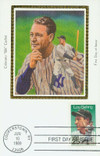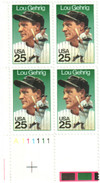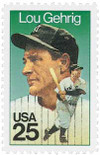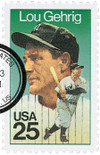
# 2417 - 1989 25c Lou Gehrig
U.S. #2417
1989 25¢ Lou Gehrig
American Sports Series
- Commemorated 50th anniversaries of Baseball Hall of Fame and Gehrig’s retirement
- Based on two photos of Gehrig during his career
- 9th Stamp in American Sports Series
Stamp Category: Commemorative
Series: American Sports
Value: 25¢, first-class rate
First Day of Issue: June 10, 1989
First Day City: Cooperstown, New York
Quantity Issued: 262,755,000
Printed by: American Bank Note Company
Printing Method: Photogravure
Format: Panes of 50 in Sheets of 200
Why the stamp was issued: To commemorate the 50th anniversary of the National Baseball Hall of Fame and the 50th anniversary of Gehrig’s retirement and Lou Gehrig Day at Yankee Stadium.
About the stamp design: Watercolor artist and baseball fan Bart Forbes was hired to illustrate the Gehrig stamp. He initially expected it to be easy, as he’d drawn baseball players before. Then he realized, “Most ballplayers or athletes, have some distinguishing feature that is fairly easy to capture. But Gehrig had almost perfect features. He had the face of a shirt model… and he kept just looking like a generic good-looking guy. So it took a while to get what I wanted.” Forbes ultimately based the larger profile on the stamp on a baseball card he found at a collectors’ convention. For the smaller action shot, he based his illustration on a photo by Herman Seid taken in 1939 at Cleveland’s Municipal Stadium.
First Day City: The First Day ceremony for this stamp was held at the National Baseball Hall of Fame in Cooperstown, New York.
About the American Sports Series: On September 22, 1981, the USPS inaugurated its Sports Series (sometimes called the American Sports Personalities Series), honoring some of America’s most notable athletes. The series ran until 2013 and honored notable athletes from a variety of sports including golf, baseball, tennis, football, and boxing. Click here to get the complete series.
History the stamp represents: Born in New York City in 1903, Henry Louis Gehrig was the son of German immigrants who’s just moved to America a few years prior. Gehrig was a gifted athlete as a child, and his mother worked extra jobs to provide him with the best possible future.
Gehrig went on to study engineering at Columbia University while playing fullback on the school’s football team. He also pitched for the baseball team, which nicknamed him Columbia Lou. But Gehrig’s strength at the bat earned him a spot on the Yankees roster in April 1923, the same year Yankee Stadium opened. Gehrig used his $1,500 signing bonus to buy his parents a nice house in the suburbs.
Gehrig made his major league debut that June and the following year replaced the aging first baseman. That marked the start of his impressive 2,130 consecutive game streak – a record that remained unbroken until 1995. Many sportswriters have used the word “durable” to describe Gehrig. Even his nickname, “The Iron Horse,” implied stability.
Gehrig’s career was full of incredible accomplishments. He set an American League record in 1931 with 184 runs batted in (RBIs); hit four home runs in one game in 1932; and earned the 1934 Triple Crown with 49 home runs, a .363 average, and 165 RBIs.
On a team with giants like Babe Ruth, Gehrig was a quiet and unassuming player. His teammates respected him all the more for playing through the incredible pain that marked his later years.
During the 1938 season, Gehrig was struggling. Though his health was beginning to fail, his statistics were higher than average in the second half of the season. Then on August 20, Gehrig stepped up to the plate in the first inning and hit a grand slam against Philadelphia Athletics pitcher Buck Ross. That earned Gehrig another record – one that wouldn’t be broken for 75 years.
The following year, Gehrig’s career was cut short when he was diagnosed with amyotrophic lateral sclerosis, which is commonly known as Lou Gehrig’s disease. On July 4, 1939, some 61,000 people attended “Lou Gehrig Appreciation Day” at Yankee Stadium. In his stirring speech, Gehrig said, “… today I consider myself the luckiest man on the face of the earth.”
Gehrig remained active in the community until his death in 1941. The tradition of retiring a player’s uniform began when Gehrig left the game in 1939. He was elected to the Hall of Fame in a special election that year.
U.S. #2417
1989 25¢ Lou Gehrig
American Sports Series
- Commemorated 50th anniversaries of Baseball Hall of Fame and Gehrig’s retirement
- Based on two photos of Gehrig during his career
- 9th Stamp in American Sports Series
Stamp Category: Commemorative
Series: American Sports
Value: 25¢, first-class rate
First Day of Issue: June 10, 1989
First Day City: Cooperstown, New York
Quantity Issued: 262,755,000
Printed by: American Bank Note Company
Printing Method: Photogravure
Format: Panes of 50 in Sheets of 200
Why the stamp was issued: To commemorate the 50th anniversary of the National Baseball Hall of Fame and the 50th anniversary of Gehrig’s retirement and Lou Gehrig Day at Yankee Stadium.
About the stamp design: Watercolor artist and baseball fan Bart Forbes was hired to illustrate the Gehrig stamp. He initially expected it to be easy, as he’d drawn baseball players before. Then he realized, “Most ballplayers or athletes, have some distinguishing feature that is fairly easy to capture. But Gehrig had almost perfect features. He had the face of a shirt model… and he kept just looking like a generic good-looking guy. So it took a while to get what I wanted.” Forbes ultimately based the larger profile on the stamp on a baseball card he found at a collectors’ convention. For the smaller action shot, he based his illustration on a photo by Herman Seid taken in 1939 at Cleveland’s Municipal Stadium.
First Day City: The First Day ceremony for this stamp was held at the National Baseball Hall of Fame in Cooperstown, New York.
About the American Sports Series: On September 22, 1981, the USPS inaugurated its Sports Series (sometimes called the American Sports Personalities Series), honoring some of America’s most notable athletes. The series ran until 2013 and honored notable athletes from a variety of sports including golf, baseball, tennis, football, and boxing. Click here to get the complete series.
History the stamp represents: Born in New York City in 1903, Henry Louis Gehrig was the son of German immigrants who’s just moved to America a few years prior. Gehrig was a gifted athlete as a child, and his mother worked extra jobs to provide him with the best possible future.
Gehrig went on to study engineering at Columbia University while playing fullback on the school’s football team. He also pitched for the baseball team, which nicknamed him Columbia Lou. But Gehrig’s strength at the bat earned him a spot on the Yankees roster in April 1923, the same year Yankee Stadium opened. Gehrig used his $1,500 signing bonus to buy his parents a nice house in the suburbs.
Gehrig made his major league debut that June and the following year replaced the aging first baseman. That marked the start of his impressive 2,130 consecutive game streak – a record that remained unbroken until 1995. Many sportswriters have used the word “durable” to describe Gehrig. Even his nickname, “The Iron Horse,” implied stability.
Gehrig’s career was full of incredible accomplishments. He set an American League record in 1931 with 184 runs batted in (RBIs); hit four home runs in one game in 1932; and earned the 1934 Triple Crown with 49 home runs, a .363 average, and 165 RBIs.
On a team with giants like Babe Ruth, Gehrig was a quiet and unassuming player. His teammates respected him all the more for playing through the incredible pain that marked his later years.
During the 1938 season, Gehrig was struggling. Though his health was beginning to fail, his statistics were higher than average in the second half of the season. Then on August 20, Gehrig stepped up to the plate in the first inning and hit a grand slam against Philadelphia Athletics pitcher Buck Ross. That earned Gehrig another record – one that wouldn’t be broken for 75 years.
The following year, Gehrig’s career was cut short when he was diagnosed with amyotrophic lateral sclerosis, which is commonly known as Lou Gehrig’s disease. On July 4, 1939, some 61,000 people attended “Lou Gehrig Appreciation Day” at Yankee Stadium. In his stirring speech, Gehrig said, “… today I consider myself the luckiest man on the face of the earth.”
Gehrig remained active in the community until his death in 1941. The tradition of retiring a player’s uniform began when Gehrig left the game in 1939. He was elected to the Hall of Fame in a special election that year.










